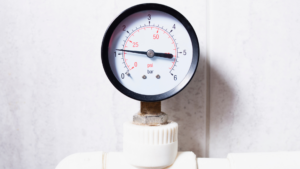
Ideal Boiler Pressure
Boiler pressure is measured in bars, roughly equivalent to 14.5 PSI (Pounds per Square Inch). Modern boilers are designed to operate between 1.5-2 bar when heating water and 1-1.5 bar when dormant. Most boilers can operate outside their intended pressure range, at least for a short amount of time.
In fact, while low pressure is often discovered quickly, excessive pressure can go unnoticed for weeks or months. Boilers cannot heat your home if the pressure falls below one bar. Radiators will either become cold or weak. In some cases, they shut down entirely. However, they will continue producing heat even if the pressure is significantly higher than two bar.
Despite what you may think, high pressure is not dangerous. Boilers have built in safety features to prevent ruptures. If the pressure climbs too high, the pressure release valve (PRV) opens and drains water from inside the boiler. In other cases, the boiler will “lock out” and stop running. However, high pressure increases the strain on pipes and valves, which, if left untreated, can cause leaks.
Low Boiler Pressure
Low boiler pressure occurs due to lack of water inside the boiler, generally caused by a leak in the tank, pipes, or radiators. If you can’t detect the leak, the best course of action is to call a technician to examine the system. Otherwise, the issue will simply recur after you’ve filled the tank.
High Boiler Pressure
High boiler pressure occurs when there is too much water inside the system, leading to an excessive amount of heat and steam. The most common cause of high pressure is homeowners overfilling the tank. In other instances, a loose expansion valve or PRV may be raising the pressure by letting air into the system. It’s also possible the filling loop valves have not been properly sealed, allowing a small amount of water to trickle in over time.
Raising Boiler Pressure
Repressurising a boiler is a simple process most homeowners can handle on their own. Though the procedure is similar for every system, it’s best to check the manufacturer’s instructions before you start, to avoid mishaps. For most boilers, you’ll need to:
- Shut down the boiler. Always deactivate the system and let it cool before repressurising it.
- Locate the filling loop. It’s a short length of braided hose or silver piping with one or two black valves, located underneath the boiler.
- Open the valves. Turn the filling valves until they’re aligned with the hose or piping. You should be able to hear water entering the system.
- Monitor the pressure gauge. When it reaches 1.2 bar, close the valves.
- Reactivate the boiler. If the pressure is holding steady at 1.2 bar, turn the boiler back on and let it warm up again. However, if the pressure drops, there’s likely a leak in the system. On the other hand, if the pressure continues to rise, double check the filling loop. The valves may not be entirely closed.
Lowering Boiler Pressure
Reducing the pressure inside the system requires you to bleed your radiators. Before you begin, you’ll need to obtain a radiator key, if you don’t have one already. They’re available at most hardware stores. Next check the filling loop and PRV are fully closed. Once you’ve confirmed no air or water is entering the system:
- Shut down the boiler. Bleeding the radiators while the boiler is running could cause scalding.
- Find the radiator valve. It’s located where the pipes enter and exit the unit.
- Open up the valve. Insert the radiator key into the valve and slowly twist it counter clockwise. You’ll hear some whistling as the air escapes. Once the air has been released, a small amount of water will trickle out. Place a towel under the radiator to soak up the loose moisture.
- Close the valve. Seal the valve as soon as water begins leaking out.
- Repeat with the remaining radiators in your home. Check the pressure gauge on the boiler after each radiator has been bled, until it reaches 1.2 bar or has at least returned to the green zone.
- Reactivate your boiler. If the pressure begins to creep up again, you’ve probably got a faulty valve. You’ll need to call a professional to discover which one.
Save Money on Boiler Repairs
Boilers are an efficient and effective way to heat your home, but like every other system, they’re prone to wear and tear. Home insurance won’t protect you from this type of damage, which is why so many Americans seek additional coverage from Agway.
Our EnergyGuardTM program provides repair coverage for your boiler, furnace, air conditioning, and electrical wiring*. When the need for repair occurs, customers don’t waste time searching for a qualified technician. Our support team is standing by 24/7, ready to help. They send out an experienced contractor and pay for the cost of the visit, as well as all covered parts. There are no service fees or deductibles. Everything is included in your supply cost. So don’t wait. Contact us and start saving on repairs today!
*Coverage depends on which commodity you purchase.